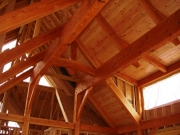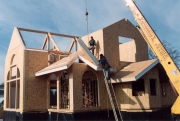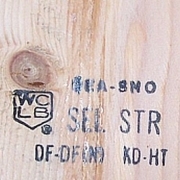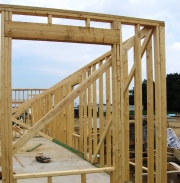- Error
{Re}habitat
Learn how adaptive reuse and upcycling can add hip design to your home, apartment, or yard with the Go Green channel's {Re}habitat series. Follow host Rachael Ranney as she shows you how to repurpose salvaged and found materials, adding fun and function to your space without breaking your budget.

Log construction refers to a building technique in which a structure is built from logs that have not been milled into conventional lumber. Log buildings are formed by horizontally stacking logs and interlocking their ends with notches. The origin of this type of construction is uncertain, but it is believed to date back to Northern Europe during the Bronze Age. When Europeans settled in America during the 17th and 18th centuries, they utilized this knowledge of handcrafted log construction to create shelter. In 19th century American politics, log cabins came to symbolize humble beginnings, since no fewer than seven U.S. Presidents were born in log homes. Throughout history, log construction was used for homes, churches, schools, barns, mills, commercial buildings, and outbuildings. Typically built in rural settings, this rustic architecture style can be built in any climate. Today log construction can be seen in elaborate homes as well as in simple cabins, built from handcrafted or milled logs, with different styles and options.
Heavy timbers are a type of lumber that is differentiated from dimensional lumber by having minimum dimensions of 5 inches. Timber framing consists of joining heavy timbers together with pegged mortise and tenon joints, scarf joints or lap joints. Wood members of heavy timber framing are commonly known as post, beam, jetty, truss and brace. Historically, heavy timbers were hewn with axes or hand sawed. Today, CNC machines have modernized what was once a hand craft, allowing the industry to grow due to greater affordability of products and shorter lead.
Structural panels are energy efficient, composite panelized systems that are manufactured assemblies used in residential and light commercial structures. Types include structural insulated panel systems (SIPs) or stressed skin panels and cementitious reinforced panels. Used on roofs, walls and floors, structural panels can reduce the time it would take to complete a building envelope with standard materials. Structural panels offer various R-Values, weather resistance, fire retardation, and has the ability to meet extreme structural requirements.
Mechanically graded lumber is lumber that has been tested and evaluated by a machine rather than by visual inspection. While most lumber is visually inspected and graded, machine grading is a more efficient volume service and creates cost-competitive products, while differentiating the higher strength lumber materials. It is commonly used to deliver materials for more demanding applications. Two types of machines are used to grade lumber, machine-stress rated (MSR) lumber and machine evaluated lumber (MEL) machines.
Engineered wood materials are manufactured products that utilize strands, particles, fibers, and veneers of wood to produce a range of different types of products. Readily available at lumber yards, these products are cut to length in the field, similar to dimensional lumber. The application of engineered wood products is also similar to that of dimensional lumber; however, each offers its own performance and manufacturing advantages. Engineered wood products also have some disadvantages in comparison to dimensional lumber. They have less fire resistant, require more energy to manufacture, have adhesives that can potentially release toxins into the environment, and are prone to moisture damage. Engineered wood products are often used as columns, beams, girders, joists, purlins, rafters, studs and bracing.
Wood framing, or light frame construction, is the assembly of dimensional lumber or engineered wood lumber that is regularly spaced and fastened together with nails to create floor, wall and roof assemblies. Wood is the most common material used within the construction industry today.
This topic covers information related to the treatment of wood with preservatives used in construction. Preservatives can be added to wood to prevent the growth of mold and deter insects. Methods of preservation include vacuum or pressure treatment with chemicals such as arsenic, copper, chromium, or borate, in addition to others.
This topic covers information related to the treatment or preservation of wood materials used in construction. Wood treatment increases durability and resistance, protecting wood from fire, moisture deterioration and insect infestation. Several types of preservatives and process exist to treat wood.







